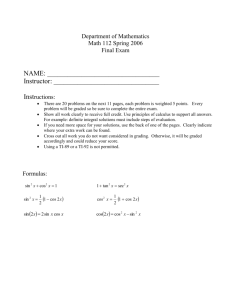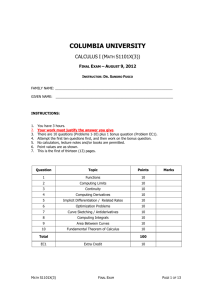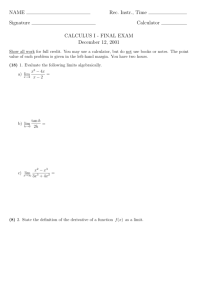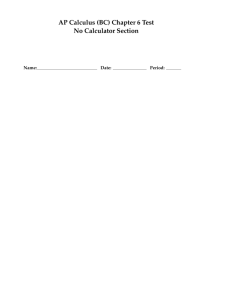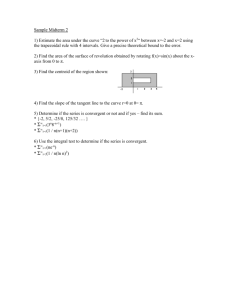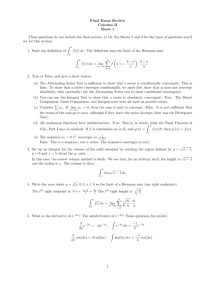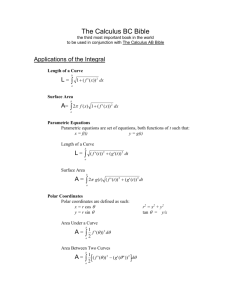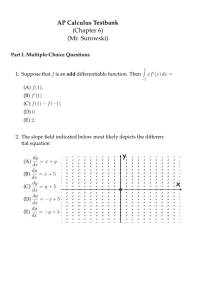Calculus II Final Exam Review: Integration, Series, and More
advertisement
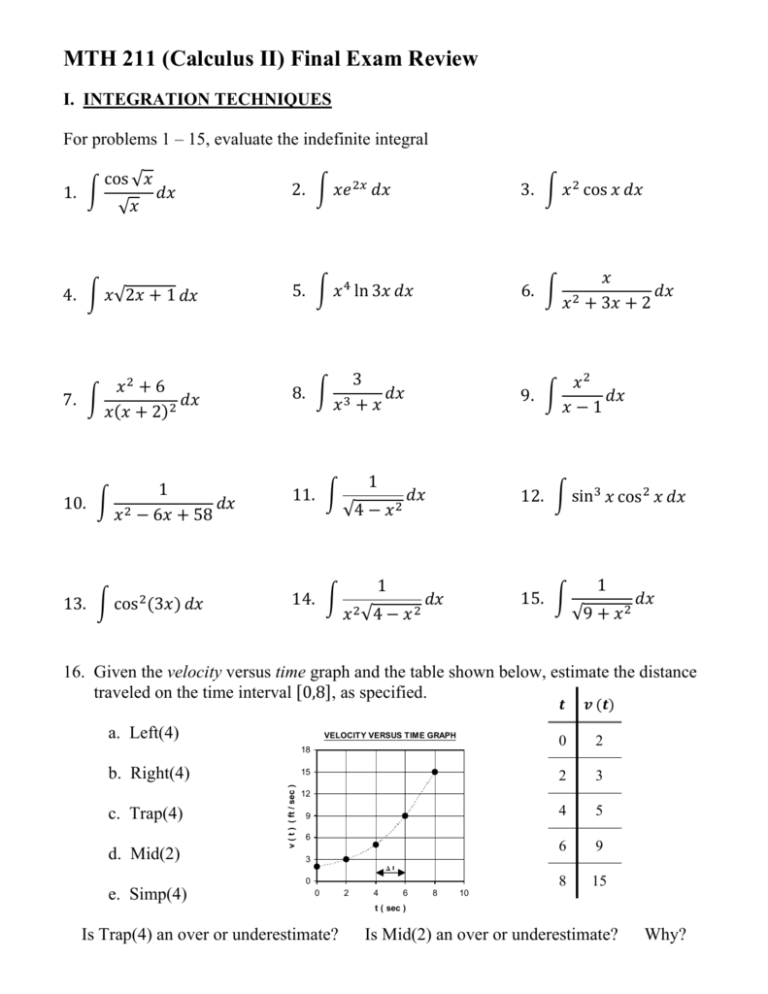
MTH 211 (Calculus II) Final Exam Review I. INTEGRATION TECHNIQUES For problems 1 – 15, evaluate the indefinite integral cos √ 1. √ 4. 3. 2. 5. 1 √2 3 7. 8. 10. 1 6 11. 13. cos 3 58 6. ln 3 6 2 3 9. 1 1 sin cos 1 15. √4 2 1 12. √4 14. cos √9 16. Given the velocity versus time graph and the table shown below, estimate the distance traveled on the time interval 0,8 , as specified. a. Left(4) VELOCITY VERSUS TIME GRAPH 18 b. Right(4) d. Mid(2) v ( t ) ( ft / sec ) c. Trap(4) 15 0 2 2 3 4 5 6 9 8 15 12 9 6 3 Dt e. Simp(4) 0 0 Is Trap(4) an over or underestimate? 2 4 6 8 10 t ( sec ) Is Mid(2) an over or underestimate? Why? II. APPLICATIONS OF INTEGRATION / 17. The region in the -plane bounded by the graphs of is revolved about the -axis. Do the following: 8, and the -axis , a. Sketch the region in the -plane. On your sketch, draw a typical rectangle that will sweep out an increment of volume. b. Draw the solid of revolution. c. Write an algebraic expression that represents the increment of volume. d. Write a Riemann Sum that approximates the volume of the solid of revolution. e. Find the exact volume of the solid by writing and evaluating the appropriate definite integral. ln sec 18. Find the arc length of the graph of on the interval 0, /3 . 19. Consider a cylindrical tank 15 feet high with a radius of 10 feet. The tank is filled to a depth of 10 feet with fluid that weighs 20 lbs/ft3. Find the work done in pumping all of the fluid out of the tank. 20. A conical tank with its point downward is 8 feet across at the top and 6 feet high. It is filled to half its height with water which weighs 62.4 lbs/ft3. How much work is done in pumping the water over the top edge of the tank to empty it? 21. How much work is done in winching up 15 feet of chain hanging from a 30 foot tower if the chain weighs 10 lbs/ft? III. DIFFERENTIAL EQUATIONS 22. For each of the following, find the particular solution of the differential equation that satisfies the given initial condition. a. 2 6 and 0 9 b. cos and 2 . 23. Below is a slope field for the differential equation 4 a. On this slope field, sketch in the solution containing the point 0,2 . 2 b. From your sketch in part a going through the point 0,2 , estimate the value of when 2. 2, When -4 -2 2 4 -2 _______ -4 c. Use Euler’s Method with four equal subdivisions to find an approximation of when 2, using this differential equation for this initial value of 2 when 0. Show a table including , , / , and the approximation of ∆ . 24. A population of size , increases over time (in years), at a rate proportional to a. Write a differential equation expressing the abovementioned relationship. b. Solve the differential equation in part a given that 100,000 when 0 and that the population doubles every 7 years (show all work from the beginning— don’t just jump to the model). Find the value of to 5 decimal places. c. If 0 corresponds to January 1st of the year 2010, give the month and year during which the population will reach 500,000. IV. LIMITS For questions 25 – 30, use L’Hopital’s Rule to find the given limit. 25. lim 28. lim 2 2 3 ln 2 26. lim sin 3 29. lim 27. lim 30. lim 1 / V. IMPROPER INTEGRALS For questions 31 – 34, determine whether the improper integral converges or diverges. If the improper integral converges, find its value. 1 31. 1 3 32. / 33. / 1 34. 1 35. a. Sketch the graph of . b. Find the area of the region bounded by the graph in part a, and the -axis for 2. 36. Use the Comparison Test for improper integrals to determine if each of the following improper integrals converges or diverges. Show all of your work! sin 2 a. b. 1 1 2√ VI. INFINITE SERIES For questions 37 – 45, determine whether the given infinite series converges or diverges. Justify your answers. 37. 40. 2 3 1 1 1 1 43. ∞ 38. 5 4 39. 41. 1 ln 42. 44. 2 45. ! 3 1 1 3 2 46. Rewrite the following series below in Sigma notation (i.e. using Σ) and then indicate the exact value that the series converges to. a. 1 b. 1 47. Consider the infinite series 1 2 . a. Find the partial fraction decomposition of b. Write an algebraic expression for the 1 1 partial sum of the series 1 c. Find the sum of the series sequence of partial sums. . 2 1 2 by calculating the limit of the 48. a. Use Sigma notation (i.e. using Σ) to express the Taylor Series centered at 0 for each of the following functions. Then write the series in expanded form by writing out the first three non-zero terms of the series followed by . sin cos b. Determine the maximum possible error if the 5th degree Taylor polynomial for sin , centered at 0 is used to approximate sin for any in the interval 0, . , c. Determine the first four nonzero terms of the Taylor Series for centered at 0 and use this polynomial to approximate . 49. Determine the radius and interval of convergence for each of the power series below. ∞ a. ∞ 2 b. ∞ ! .
